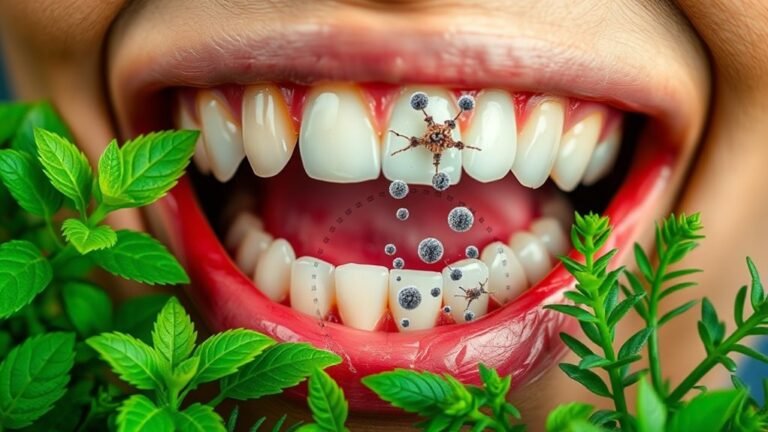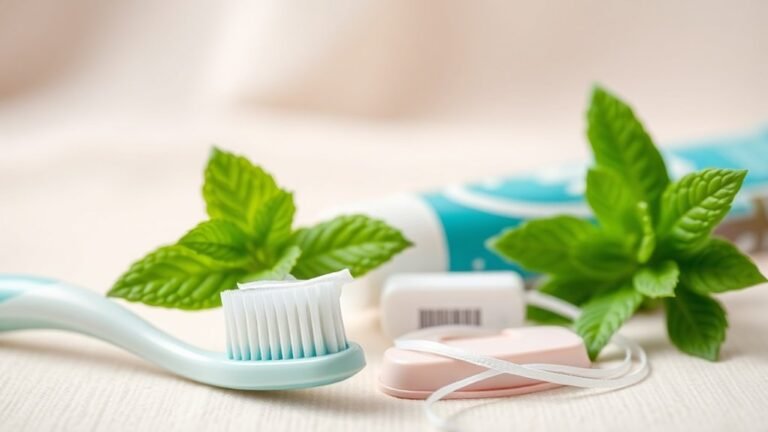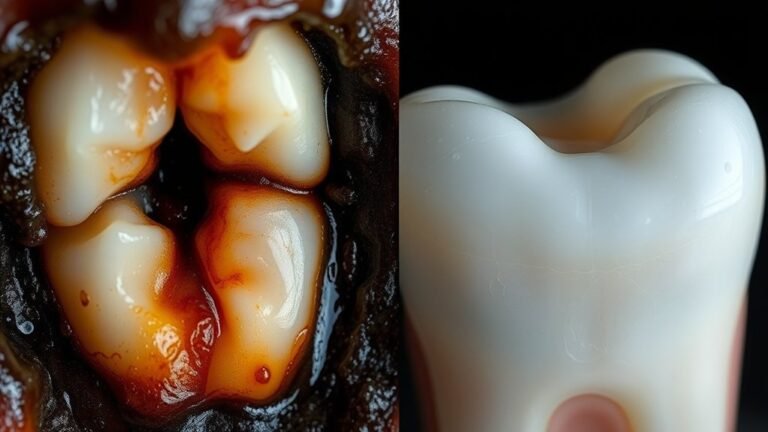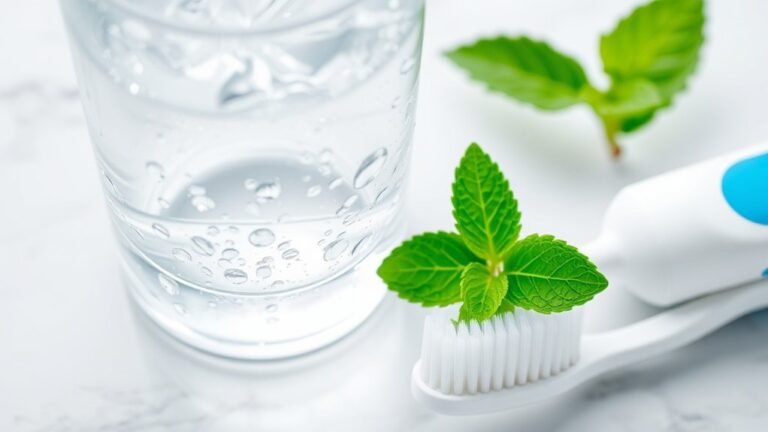Can Genetically Altered Oral Bacteria Prevent Cavities
Genetically altered oral bacteria can indeed help prevent cavities. These modified strains target harmful bacteria like Streptococcus mutans, disrupting their growth and reducing acid production that damages tooth enamel. Research shows that these engineered bacteria may outcompete cavity-causing pathogens, leading to a healthier oral microbiome. While promising, it’s crucial to evaluate safety and ethical implications before widespread use. Discover how this innovative approach could revolutionize dental care and what it means for you.
Key Takeaways
- Genetically altered bacteria can restore balance in the oral microbiome, reducing the prevalence of cavity-causing pathogens like Streptococcus mutans.
- Modified bacteria may produce antimicrobial compounds that effectively target and disrupt harmful biofilms associated with cavity formation.
- Clinical trials are underway to evaluate the safety and efficacy of genetically modified bacteria for cavity prevention in humans.
- These innovations could provide a proactive approach to cavity prevention, potentially reducing reliance on traditional dental treatments.
- Ethical considerations and public engagement are crucial for the acceptance and responsible use of genetically engineered bacteria in dental care.
Understanding Oral Bacteria and Their Role in Cavities
Understanding oral bacteria is essential for grasping how they contribute to cavities. The oral microbiome is a complex ecosystem, with various bacteria coexisting in your mouth. Among these, streptococcus mutans plays a pivotal role in cavity formation. This bacterium ferments sugars, producing acids that demineralize tooth enamel. When the balance of your oral microbiome is disrupted, pathogenic bacteria can flourish, leading to an increased risk of cavities. Recent advancements in genetic engineering have introduced genetically altered bacteria aimed at restoring this balance. These modified strains can potentially outcompete harmful bacteria like streptococcus mutans, thereby reducing cavity incidence. By understanding these dynamics, you can appreciate the importance of maintaining a healthy oral environment for cavity prevention.
The Science Behind Genetic Modification
While genetic modification may sound complex, it fundamentally involves altering an organism’s DNA to achieve desired traits. This approach can enhance probiotic treatment by introducing genes that promote cavity prevention. By focusing on biofilm disruption, scientists aim to engineer bacteria that outcompete harmful strains, thereby reducing cavity-causing plaque formation.
| Genetic Modification Aspect | Impact on Cavity Prevention |
|---|---|
| DNA Alteration | Enhances beneficial traits |
| Probiotic Integration | Reduces harmful bacteria |
| Biofilm Disruption | Prevents plaque accumulation |
Through these strategic modifications, the potential for engineered oral bacteria to revolutionize dental health becomes evident. You can see how targeted genetic changes contribute to a healthier oral microbiome and improved cavity prevention strategies.
Current Research on Genetically Altered Bacteria
Recent advancements in genetic engineering have sparked significant interest in the development of genetically altered oral bacteria as a means to combat cavities. Current research focuses on modifying specific strains of bacteria to enhance their ability to outcompete harmful pathogens associated with tooth decay. Scientists are investigating engineered strains that can produce antimicrobial compounds, potentially reducing the prevalence of cavity-causing bacteria like Streptococcus mutans. Studies have shown promising results in laboratory settings, where these modified bacteria demonstrated improved tooth decay prevention compared to traditional oral microbiota. Ongoing clinical trials aim to evaluate the safety and effectiveness of these alterations in human subjects. As research progresses, the potential for genetically altered bacteria in oral health strategies becomes increasingly viable.
Potential Benefits of Modified Microorganisms
Genetically modified microorganisms offer several potential benefits that could revolutionize oral health care. By engineering bacteria to produce antimicrobial substances, you could reduce harmful oral pathogens responsible for cavities and gum disease. Enhanced strains might also promote a balanced oral microbiome, preventing the overgrowth of cavity-causing bacteria like Streptococcus mutans. Additionally, modified bacteria could improve enamel remineralization, actively repairing early tooth decay. Studies suggest that these microorganisms can be tailored to target specific pathogens without disrupting beneficial bacteria. This precision can lead to more effective treatments, minimizing side effects associated with traditional antibiotics. Overall, harnessing these modified microorganisms could provide a proactive approach to dental health, transforming preventive care and reducing the incidence of cavities considerably.
Challenges and Ethical Considerations
As scientists explore the potential of genetically modified oral bacteria, they must confront significant challenges and ethical considerations that could impact their implementation in dental care. One major challenge lies in ensuring the safety and effectiveness of these modified organisms. There’s a risk of unintended consequences, such as adverse reactions or the disruption of natural oral microbiomes. Ethically, questions arise about consent, especially in pediatric patients, and the potential for socioeconomic disparities in access to such treatments. Regulatory frameworks are also insufficiently developed to govern the use of genetic modifications in non-human organisms. You must consider these factors carefully, as they will influence public perception and acceptance, ultimately determining the viability of genetically altered bacteria in preventing cavities.
Future Implications for Dental Care
As you consider the future of dental care, innovative treatment strategies using genetically altered oral bacteria could transform how cavities are managed. These advancements promise long-term health benefits, potentially reducing the incidence of dental diseases. However, it’s vital to weigh these benefits against the ethical considerations surrounding genetic modifications.
Innovative Treatment Strategies
While traditional dental treatments often focus on addressing symptoms rather than underlying causes, innovative strategies leveraging genetically altered oral bacteria are poised to revolutionize dental care. By manipulating the genetic makeup of specific bacteria, researchers aim to enhance the oral microbiome’s ability to combat harmful pathogens that lead to cavities. For instance, genetically engineered strains of bacteria can produce antimicrobial compounds, effectively reducing the prevalence of cavity-causing agents. Clinical studies highlight the potential of these innovations to not only prevent cavities but also to promote overall oral health. As you consider these advancements, it is crucial to recognize their implications for personalized dental care, offering tailored solutions that align with individual microbiomes and lifestyles, ultimately enhancing both efficacy and patient satisfaction.
Long-term Health Benefits
The integration of genetically altered oral bacteria into dental care could greatly reshape long-term health outcomes, particularly regarding cavity prevention and overall oral hygiene. By enhancing the oral microbiome, these engineered bacteria can outcompete harmful pathogens, markedly reducing the incidence of caries. Studies suggest that maintaining a balanced oral microbiome not only prevents cavities but also contributes to reduced inflammation and better gum health. As you adopt this innovative approach, you may experience fewer dental visits, lower treatment costs, and improved quality of life. Over time, widespread use of these bacteria could lead to a paradigm shift in preventive dentistry, fostering an era where dental diseases are managed more effectively through biological means rather than traditional interventions.
Ethical Considerations Ahead
Given the rapid advancement of genetically altered oral bacteria in dental care, it’s important to examine the ethical considerations that accompany this innovative approach. You’ll need to reflect on the potential risks of unintended consequences, such as the creation of antibiotic-resistant strains. Additionally, the long-term effects on the microbiome remain largely unknown, raising questions about safety and efficacy. Informed consent becomes significant, as patients must understand the implications of altering their oral flora. Equity in access to such treatments is another concern; will low-income populations be excluded from these advancements? Finally, you should reflect on the environmental impact of releasing genetically modified organisms into ecosystems. Addressing these ethical issues will be key in ensuring responsible implementation in future dental care practices.
Comparing Traditional Methods With Genetic Solutions
When you consider cavity prevention, traditional methods like fluoride treatments and sealants have long been the standard. However, genetic engineering innovations offer new avenues that could enhance efficacy and safety in oral health. By comparing these approaches, you can better understand the potential benefits and drawbacks of each strategy.
Traditional Cavity Prevention Techniques
While traditional cavity prevention techniques, such as regular brushing, flossing, and fluoride treatments, have long been the cornerstone of oral health, emerging genetic solutions offer a fascinating alternative that could revolutionize how we combat tooth decay. You rely on these established methods because they effectively reduce plaque buildup and strengthen enamel. Studies show that fluoride can meaningfully decrease the incidence of cavities, while daily brushing and flossing remove food particles and bacteria. However, these practices require consistency and can sometimes be inadequate for everyone. In contrast, genetic approaches may target bacterial strains directly, potentially offering a more tailored and proactive solution. Understanding the strengths and limitations of both methods will be essential as we move toward a future of integrated oral health strategies.
Genetic Engineering Innovations
As researchers explore genetic engineering innovations, it’s clear that these solutions may complement or even surpass traditional methods in preventing cavities. Traditional techniques, like fluoride treatments and sealants, focus on external factors, relying on routine application to protect teeth. In contrast, genetic engineering directly modifies oral bacteria to enhance their protective functions. For instance, scientists can alter bacteria to produce antimicrobial peptides, which actively combat cavity-causing pathogens. This targeted approach offers a more proactive strategy, potentially reducing the need for frequent interventions. Additionally, genetic solutions can adapt to individual microbiomes, providing personalized cavity prevention. By harnessing these innovations, you could experience a significant shift in oral health practices, leading to more effective and lasting results against cavities.
Efficacy and Safety Considerations
Although traditional methods like fluoride treatments and sealants have proven effective in cavity prevention, their reliance on regular application raises questions about long-term efficacy and safety. You might find that while these methods reduce cavity risk, they don’t address the underlying bacterial causes. Genetically altered oral bacteria, designed to outcompete harmful strains, could offer a promising alternative. Early studies suggest these engineered bacteria can greatly lower cavity-causing bacteria without the need for frequent applications. However, safety concerns about long-term effects and potential unintended consequences remain. Clinical trials are essential for evaluating both efficacy and safety in diverse populations. Ultimately, you’ll need to weigh the benefits of genetic solutions against the established yet imperfect traditional methods.
Frequently Asked Questions
How Are Genetically Altered Bacteria Administered to Patients?
Genetically altered bacteria are typically administered through oral delivery methods, such as lozenges or mouth rinses. These formulations guarantee the bacteria reach your oral cavity effectively, where they can establish themselves and exert their beneficial effects.
What Are the Long-Term Effects of Using Modified Oral Bacteria?
The long-term effects of using modified oral bacteria include potential alterations in your oral microbiome, immune responses, and dental health. Ongoing research is essential to guarantee safety and efficacy over extended periods.
Can Anyone Use Genetically Altered Bacteria for Cavities?
Yes, anyone can potentially use genetically altered bacteria for cavities, but it’s essential to consult a dental professional first. Individual health conditions and potential risks must be considered before proceeding with any treatment involving modified bacteria.
How Much Do Genetically Modified Treatments Cost Compared to Traditional Methods?
Genetically modified treatments often cost considerably more than traditional methods, sometimes exceeding thousands of dollars. However, their long-term benefits may offset initial expenses, depending on individual circumstances and the severity of dental issues you’re facing.
Are There Any Known Side Effects of Genetically Modified Oral Bacteria?
Yes, there are potential side effects of genetically modified oral bacteria, including allergic reactions, unintended microbial interactions, and disruption of oral microbiome balance. Research continues to evaluate these risks to guarantee safety and effectiveness in treatments.
Conclusion
As dental care evolves, genetically altered oral bacteria might serve as a revolutionary tool against cavities, much like a custom-made key that perfectly fits a lock. Research shows that modifying these microorganisms could greatly reduce cavity-causing bacteria, offering a potential breakthrough in preventive care. However, maneuvering the challenges and ethical implications is vital. By balancing innovative approaches with traditional methods, we can pave the way for a healthier future, ensuring our smiles remain bright and cavity-free.






